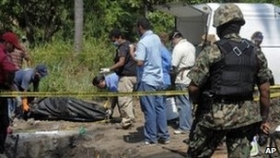On Wednesday Mexican Federal Police arrested Miguel Gomez Vasquez, alias ‘El Gato,’ the alleged leader of an assassination ring for the newly-formed Independent Cartel of Acapulco, linking him to two recent massacres in the city. The purported emergence of this ‘Acapulco Cartel’ illustrates how the government’s policy of going after cartel leaders in the region is fragmenting them into smaller, autonomous factions, much like the criminal groups in Colombia.
According to Mexico’s El Universal, Gomez was linked to the disappearance and death of twenty men traveling from Michoaocan to Acapulco to find work, in an apparent case of mistaken identity. The organization behind the killings, the Independent Cartel of Acapulco, is a small, relatively new organization with purported links to the Sinaloa Cartel.
Gomez’s arrest is part of a broader trend in Mexico, as officials increasingly go after leaders of drug trafficking organizations in an attempt to bring about their eventual collapse. In a recent press statement, Mexican security spokesman Alejandro Poire told El Milenio that about half of the 37 most dangerous criminal leaders of Mexico have been captured or killed. This has dealt “severe and irreparable damage to the structures of operations of all organized crime organizations,” Poiré said. “In an historic feat, we have done more than half of the task at hand.”
This strategy of pursuing the top drug ‘capos’ has led to comparisons with Colombia’s security problem in the 1980s, and some view the security advances Colombia as proof that Mexico’s current approach can work. And despite criticism of this analogy from the Mexican government, the fact that an increasing number of Mexican soldiers and policemen are receiving counter-narcotics training in Colombia means that policy makers in both countries, at the very least, see some parallels in their respective security situations.
But as the Colombia case illustrates, the government’s offensive against major organized criminal groups (marked by arrests and killings of high-ranking criminals) has resulted in their fragmentation into smaller, more agile cells. This fragmentation, ultimately, has done relatively little to reduce violence in Colombia. Although Colombia reported a record low homicide rate in 2010, its murder rate was still 32 per every 100,000 people, nearly twice that of Mexico’s, at 15.
As Colombian authorities targeted the leaders of major mafia groups like the Norte del Valle Cartel or the Oficina de Envigado, mid-level commanders have split away and formed their own factions. This phenomenon also occurred alongside the demobilization of the United Self-Defense Forces of Colombia (Autodefensas Unidas de Colombia – AUC) in 2006. The result is an overabundance of regional, low-level groups like the Paisas, the Aguilas Negras, and another gang based in Guajira. As these new organizations struggled to establish themselves and consolidate their position in the criminal foodchain, violence shifted away from isolated rural regions and towards highly-populated urban centers. In effect, the strategy of targeting cartel leaders has lead Colombia towards a state of “disorganized” crime. And, as the appearance of the ‘Acapulco Cartel’ may indicate, Mexico may be heading down that path as well.
This sentiment is echoed by a growing body of criticism from civil society organizations. According to a November 2010 report by the Washington Office on Latin America, Mexico’s current approach, far from eliminating the cartels, “has had deleterious effects on both society and institutions…[and] has had little effect on cocaine flows with no effect at all on violence levels.” The researchers argue that current policy merely transforms them from more professional, hierarchical organizations with clear chains of command to organizations where the more violent, unsophisticated elements compete to fill power vacuums.
Perhaps as concrete proof of this behavior, authorities were able to link Gomez Vasquez and his Independent Cartel to the recent spree of violence in Acapulco. The city saw 28 people killed in one weekend less than a month ago, sixteen of which were decapitated and found dumped on the sidewalk in front of a shopping center.

